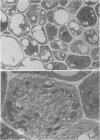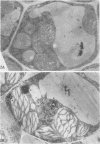Abstract
The use of microautoradiography at the electron microscopic level indicates that the vacuole is the site of accumulation of the cyanogenic glucoside of Sorghum bicolor. When a specific biosynthetic precursor of dhurrin, p-hydroxy[3,5-3H]phenylacetaldoxime, was used, 90% of the tritium label was recovered in the vacuoles of tissue prepared for microautoradiography. l-[3,5-3H]Tyrosine and d-[1-3H(N)]glucose, nonspecific precursors of dhurrin, of differing solubilities and biosynthetic capacity, were also fed to the shoots. The data obtained from these controls indicated that the high recovery of label in the vacuole of aldoxime-fed shoots was not indicative simply of the size of the vacuole, nor was it a result of movement of labeled compounds during preparation of the tissue for electron microscopy. The problem of movement of these labeled compounds during dehydration of tissue was dramatically reduced by chemical dehydration in 2,2-dimethoxypropane in less than 30 minutes rather than with routine dehydration in acetone or alcohol series for 24 hours.
Full text
PDF





Images in this article
Selected References
These references are in PubMed. This may not be the complete list of references from this article.
- Ashford A. E. Histochemical localization of beta-glycosidases in roots of Zea mays. I. A simultaneous coupling azo-dye technique for the localization of beta-glucosidase and beta-galactosidase. Protoplasma. 1970;71(3):281–293. doi: 10.1007/BF01279637. [DOI] [PubMed] [Google Scholar]
- CARO L. G., VAN TUBERGEN R. P., KOLB J. A. High-resolution autoradiography. I. Methods. J Cell Biol. 1962 Nov;15:173–188. doi: 10.1083/jcb.15.2.173. [DOI] [PMC free article] [PubMed] [Google Scholar]
- Fisher D. B. Artifacts in the Embedment of Water-soluble Compounds for Light Microscopy. Plant Physiol. 1972 Feb;49(2):161–165. doi: 10.1104/pp.49.2.161. [DOI] [PMC free article] [PubMed] [Google Scholar]
- Fisher D. B., Housley T. L. The Retention of Water-soluble Compounds during Freeze-Substitution and Microautoradiography. Plant Physiol. 1972 Feb;49(2):166–171. doi: 10.1104/pp.49.2.166. [DOI] [PMC free article] [PubMed] [Google Scholar]
- KOUKOL J., MILJANICH P., CONNEE The metabolism of aromatic compounds in higher plants. VI. Studies on the biosynthesis of dhurrin, the cyanogenic glucoside of Sorghum vulgare. J Biol Chem. 1962 Oct;237:3223–3228. [PubMed] [Google Scholar]
- Nevins D. J. Relation of glycosidases to bean hypocotyl growth. Plant Physiol. 1970 Sep;46(3):458–462. doi: 10.1104/pp.46.3.458. [DOI] [PMC free article] [PubMed] [Google Scholar]
- Outlaw W. H., Fisher D. B. Compartmentation in Vicia faba Leaves: I. Kinetics of C in the Tissues following Pulse Labeling. Plant Physiol. 1975 Apr;55(4):699–703. doi: 10.1104/pp.55.4.699. [DOI] [PMC free article] [PubMed] [Google Scholar]




